GNS3 (Graphical Network Simulator) is one of the most popular network simulator software used by hundreds of thousands of network engineers worldwide to emulate, configure, test and troubleshoot virtual and real networks. GNS3 supports a large number of vendors such as MikroTik, Cisco, Juniper, Windows, Linux and many other vendors. GNS3 can be installed on Windows, Linux and MAC Operating System. In this article, I will show how to download and install GNS3 application in Windows Operating System. I will also show how to configure a basic network in GNS3 that will communicate with the real networks.
GNS3 Download for Windows Operating System
GNS3 is completely free and open source software. So, it can be downloaded from its official website without any charge. In GNS3 official website, the installation file is found for major three operating platforms (Windows, Linux and MAC). The following steps will show how to download GNS3 installation file (.exe) for Windows Operating System.
- Go to GNS3 official website (gns3.com) from your favorite web browser.
- You must Sign Up and Login before any download. So, Sign Up and Login with your personal information.
- Now click on DOWNLOAD menu item. GNS3 current version (now it is 2.1.9) information will appear with a download button. Click on this Download button. GNS3 download pop up window will appear where installer file for major three operating systems will be found.
- Click on Download button under Window operating system. Within a few seconds your download will be started. The installer file (GNS3-2.1.9-all-in-one.exe) size is about 54.5 MB.
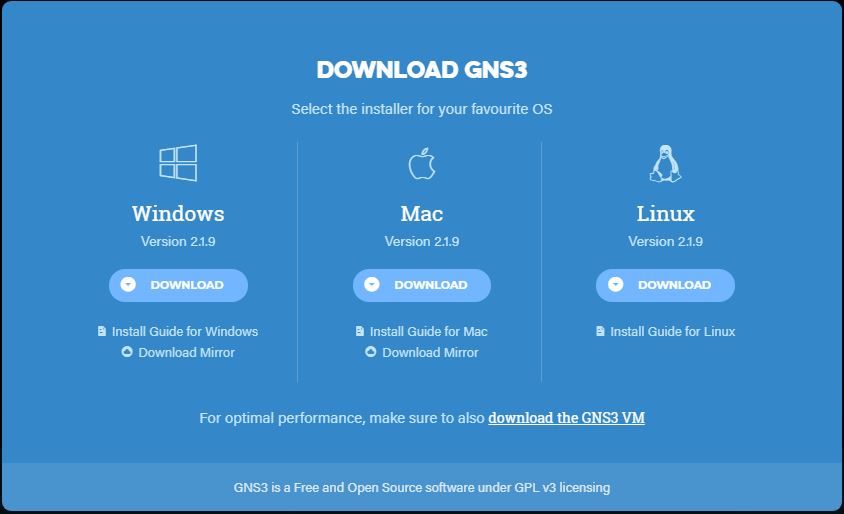
GNS3 Installation Step by Step on Windows Operating System
After completing GNS3 installer file download, we will now start installation on Windows Operating System. But before going to start installation, we have to check system requirements. For GNS3 v2.1.9, we have to use minimum Windows 7 SP1 (64 bit), 4GB RAM and IGB free storage. To get detail about GNS3 installation requirements, visit GNS3 installation minimum, recommended and optimal requirements page.
The following steps will show how to install GNS3 on Windows Operating System.
- Click twice on your downloaded GNS3 Windows installer file (GNS3-2.1.9-all-in-one.exe). A security warning window will appear. Inside this window, click on Run button.
- GNS3-2.1.9 Setup starting window will appear to welcome you. Nothing to do in this window. Just click on Next button.
- License Agreement window will appear. Accept the license agreement clicking the I Agree button.
- Choose Start Menu Folder window will appear. Keep default name (GNS3) or if you wish you can change it. Click on Next button.
- Choose Components window will appear where available GNS3 features will be listed. Among these features uncheck only Wireshark, SolarWinds Response and Npcap features because initially we don’t require these features. Now click Next button.
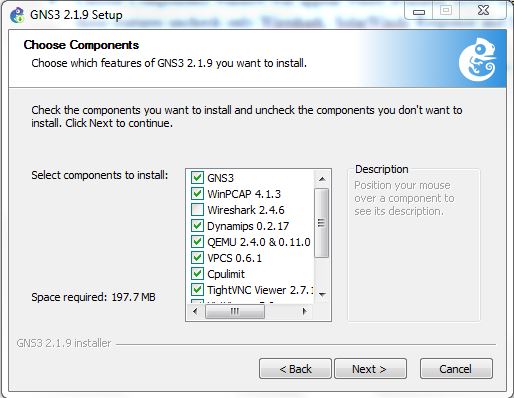
Introduction to GNS3 GUI
After completing GNS3 installation, you will find GNS3 shortcut icon in your Desktop. GNS3 icon can also be found in Windows Start menu. Run GNS3 from Desktop or Start menu. You will find GNS3 GUI like below image.
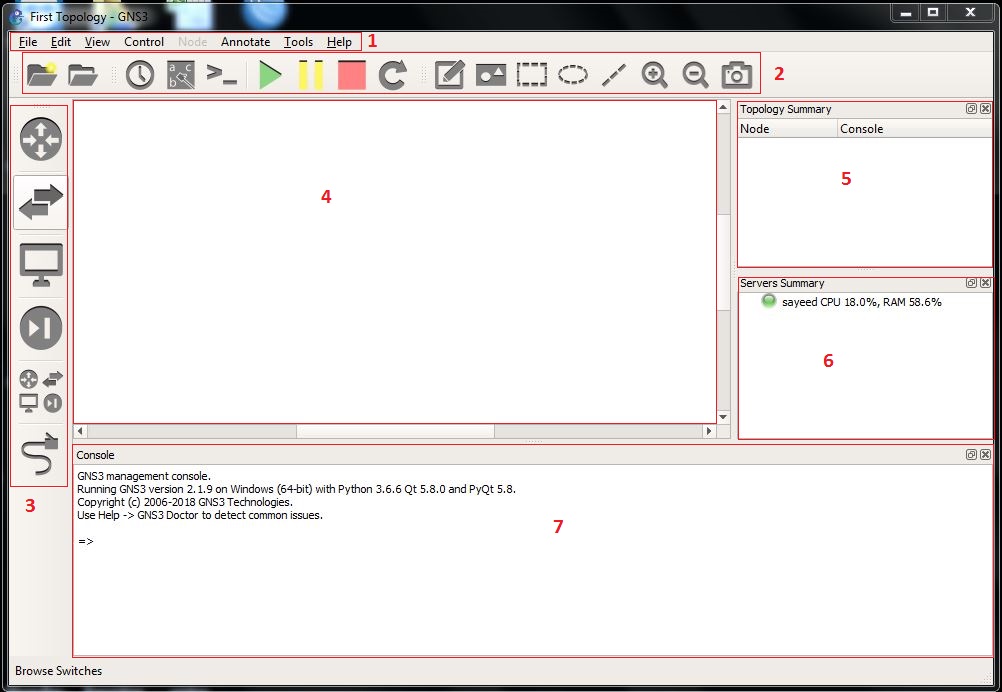
The GNS3 GUI is subdivided into several sections. These are the Menubar, Toolbar, Device Toolbar, Workspace, Topology Summery, Servers Summery and the Console section.
GNS3 Menubar
The GNS3 Menubar ((labeled 1)) found at the top of the GNS3 GUI that contains several menu items which are frequently required to manage GNS3 GUI. Each menu item contains several options such as New blank project, Open project, Import appliance, Preference, Setup Wizard and so on.
GNS3 Toolbar
The GNS3 Toolbar (labeled 2) is located below the Menubar. It contains groups of icons that allow you to easily perform common tasks.
Device Toolbar
The GNS3 Device Toolbar (labeled 3) is categorized by network devices such as Routers, Switches, End Devices, Security, All Devices, along with the Add a Link button at the bottom that looks like a network cable.
GNS3 Workspace
The GNS3 Workspace (labeled 4) is where network devices will be dragged and dropped from Device Toolbar in order to build our topology.
Topology Summery
The Topology Summery panel (labeled 5) will display the current devices in the GNS3 Workspace, their status (on/off/suspended), as well as which devices are connected to one another.
Servers Summery
The Servers Summery panel (labeled 6) will display the servers in use (local GNS3, local GNS3 VM, and remote GNS3 VM), their status (on/off) and their current resource usage.
GNS3 Console
The GNS3 Console panel (labeled 7) will display any errors or any issues GNS3 itself encounters, and will output those messages in this panel.
First Topology with GNS3
After installing GNS3, it is time to simulate and study our desired network. Now we will design a basic network in GNS3 that will communicate with real network. Our basic network is placed in GNS3 workspace like the below image.

In this basic network, we have an internet cloud which is connected to GNS3 server’s network adapter. So, any device connected to this cloud will be able to connect to real network. We also have an Ethernet switch connected to the internet cloud and two VPCSs connected to the Ethernet switch . Virtual PC Simulator (VPCS) is a program that allows you to simulate a PC supporting DHCP and ping. So, we can easily test and study our network configuration using VPCS.
We will now design this basic network in our GNS3 GUI. So, run GNS3 GUI from Windows Start Menu or Desktop and follow the below steps to design this network in GNS3.
- Go to File menu and click on New blank project item. Project window will appear. Inside Project window, put a project name in Name input field and then click OK button.
- Now click on Browse all devices button from Device Toolbar. All devices panel will appear at right side. Inside this panel you will find Installed and available appliances for GNS3. Choose only Installed appliances from drop down menu. A few installed appliances will be found inside this panel.
- Drag and Drop the Cloud appliance to GNS3 Workspace and place it according to above network diagram. If you wish you can rename it as you like clicking twice on the appliance name.
- Right click on the cloud icon and click on Configure option. Node properties window will appear. Inside this window, click on Ethernet interfaces tab. Inside Ethernet interfaces tab, choose your desired network adapter that you want to bind with this cloud from dropdown menu and then click on Add button. (If you don’t find your desired network adapter in dropdown menu, click on Show special Ethernet interfaces checkbox and you will find that your desired network adapter will now be available in interface dropdown menu). Your added network adapter will be listed in the Ethernet interfaces box area. Now click Apply and OK button.
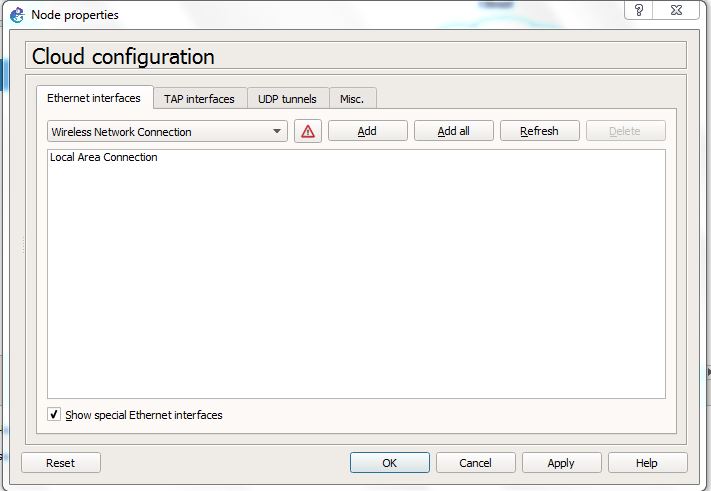
- Again Drag and Drop an Ethernet Switch and Two VPCSs in GNS3 Workspace and place them according to the above network diagram.
- You will find status (on/off) of your devices in Topology summery panel. If your device is on, it will turn into green light otherwise it will be red.
- Now click on Add a link button from Device Toolbar and move to Workspace. Mouse icon will turn into PLUS SIGN (+). Click on Cloud icon and it will ask to choose a network adapter showing the available network adapters. Click on your desired network adapter and move mouse to switch icon and click on it. It will also ask to choose an Ethernet port showing all available Ethernet ports. Click on an Ethernet port which you want to connect to internet. Now you will find a link is established between switch and internet cloud indicating green light signs that mean both devices are up and running and ready to communicate with each other.
- Similarly, connect both VPCS and Switch and then click on Add a link button again so that mouse icon shows normally in Workspace. You will find VPCS is indicating red light because VPCS is by default in off state. Start VPCS by clicking mouse right button on it and choosing Start option. Now you will find the red light will turn into green.
Our first network in GNS3 is ready. Now we will assign our LAN IP in PC-1 and PC-2 so that it can communicate to our real LAN devices as well as to WAN networks.
Assigning IP in GNS3 VPCS
VPCS is a PC simulator that helps to test network configuration with ping and trace route. VPCS supports either DHCP or static IP. In this article, we will assign static IP in our VPCSs (PC-1 and PC-2) and test whether it can communicate with real network or not.
Assign Static IP in PC-1
The following steps will show how to assign static IP address in PC-1.
- Click mouse right button on PC-1 icon and then click on Console option. PC-1 command prompt will appear.
- Issue ip command in PC-1 terminal with this format:[ip ip_address/netmask gateway] example: ip 10.10.200.2/24 10.10.200.1
- To set DNS, issue dns command with ip command: [ip dns dns_ser_ip] example: ip dns 8.8.8.8
- To save this IP configuration, issue save command.
- If you have misconfigured the IP settings, issue clear ip command to clear IP settings.
- To show IP configuration, run show ip command.
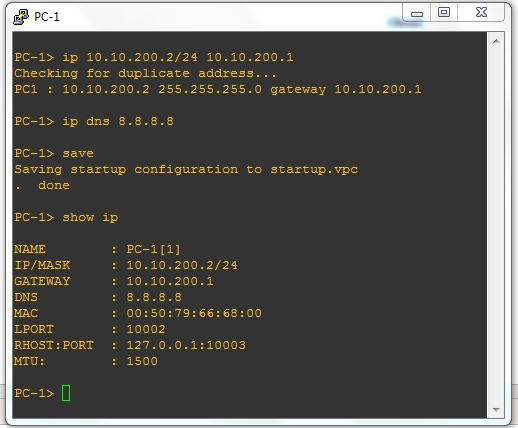
Now ping to gateway or any public domain or trace route with trace command. If everything is OK, PC-1 will be able to ping and trace route to real networks.
Assign Static IP in PC-2
The following steps will show how to assign static IP address in PC-2.
- Click mouse right button on PC-2 icon and then click on Console option. PC-2 command prompt will appear.
- Issue ip command in PC-2 terminal with this format:[ip ip_address/netmask gateway] example: ip 10.10.200.3/24 10.10.200.1
- To set DNS, issue dns command with ip command: [ip dns dns_ser_ip] example: ip dns 8.8.8.8
- To save this IP configuration, issue save command.
- If you have misconfigured the IP settings, issue clear ip command to clear IP settings.
- To show IP configuration, run show ip command.
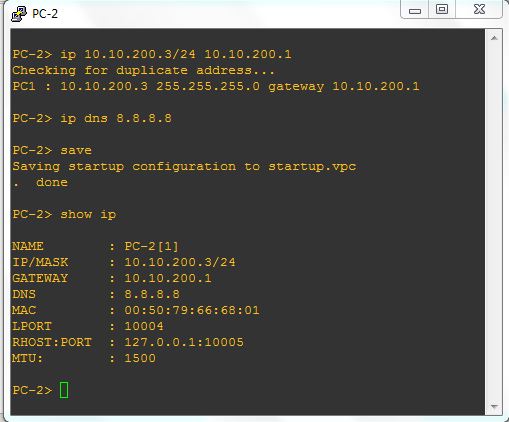
Now ping to gateway or any public domain or trace route with trace command. If everything is OK, PC-2 will be able to ping and trace route to real networks.
If you face any confusion to follow above steps properly, watch the below video about GNS3 installation and configuration in Windows Operating System. I hope it will reduce your any confusion.
This is the starting with GNS3 application. In future we will learn more complex appliance and network in GNS3 application.
GNS3 download, installation and configuration in Windows Operating System has been discussed in this article. I hope you will now be able to install and configure GNS3 successfully in your Windows OS. However, if you face any confusion to install and configure GNS3 in Window OS, feel free to discuss in comment or contact with me Contact page. I will try my best to stay with you.